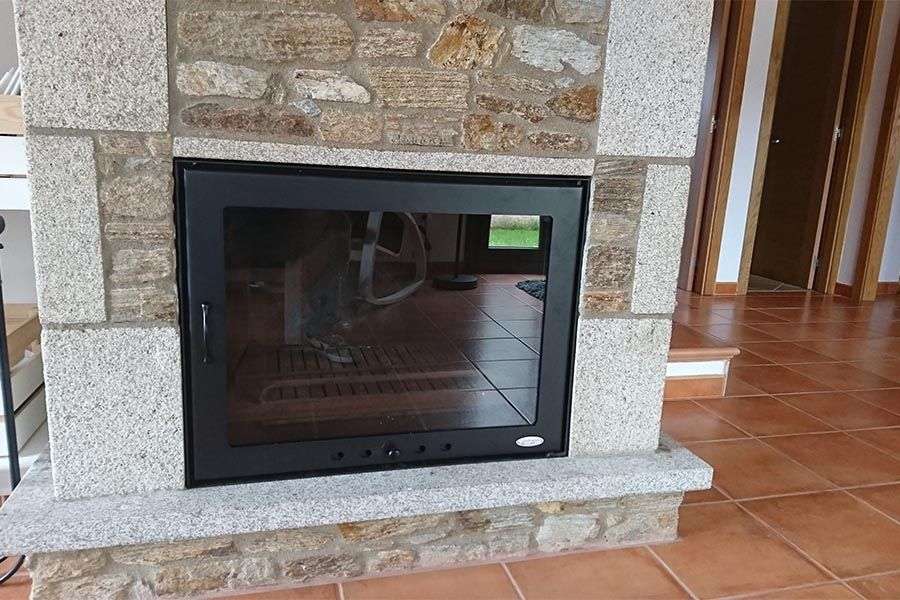
If you are thinking about getting a wood stove, you may not know exactly how to install it to take full advantage of this heating method. The truth is that it’s not too complicated, and in a few hours, you can have a modern fireplace with a rustic style working perfectly. However, the characteristics of the room where you want to install it will influence whether this is more or less straightforward.
Ideally, in these cases, you should leave the work in the hands of someone with experience, preferably a professional who knows exactly what they are doing. This way, we ensure that the stove will work as best as possible. If we install the stove and don’t do it properly, fixing the mistakes will cost much more, both in time and money.
Next, we will provide you with a detailed guide on how to efficiently and safely install a wood stove, addressing aspects such as the materials used, regulations, and tips to ensure optimal operation.
Contenidos:
Choosing the right wood stove
Before starting with the installation, it is important to choose the right wood stove for your home. Consider factors such as size, heating power, and energy efficiency. Also, make sure that the stove complies with the current regulations and certifications in your country or community.
Size and heating power
To determine the necessary power, calculate the volume of the room where the stove will be installed (length x width x height) and multiply the result by the thermal insulation factor of your home. For example, if your house is well-insulated, you can use a factor of 30, while if it is poorly insulated, use a factor of 60. The required heating power (in kW) will be the result of dividing the volume by the insulation factor.
Energy Performance
The energy performance of the stove is an important factor to consider as it determines the amount of heat that is extracted from the firewood. Opt for stoves with a performance rate above 70%, as they ensure greater efficiency and lower fuel consumption.
Where to place the stove: space and flooring
The area where we want to place the stove must have a cleared area of at least 1.2 meters all around.
Especially if we have flammable items such as wooden furniture, curtains, or carpets, all of these must be kept away from any heat source. If the floor is flammable, we must place an insulating base that prevents the heat from the stove from transferring and causing damage. This base should extend at least 30 centimeters forward and 15 centimeters on each side of the stove.
Smoke outlet and connection to the chimney
The smoke outlet must ensure proper ventilation. For this, it must be ensured that the pipe is straight, without angles that reduce efficiency. If a bend is necessary, it should not exceed 45 degrees. Additionally, it would be advisable to install custom fireplace doors to isolate the fire and always channel it upwards.
Use stainless steel or vitrified pipes, which are resistant to high temperatures and corrosion. Make sure the diameter of the pipe matches that of the stove outlet and the chimney.
Height and finish of the stove
The size of the chimney outlet will largely depend on the characteristics of the house, although the higher the pipe, the better the draft will be. It is best for the diameter to be the same as the stove outlet. It is not recommended to expand or reduce it.
Additionally, install a cap or chimney cap on the chimney outlet to prevent the entry of water, animals, or foreign objects. Make sure the cap has a spark arrestor mesh to prevent roof fires.
Around the outlet, on the exterior, there should be a space of about 10 meters where there are no elements that block the outlet, such as trees or walls. The pipe should rise at least one meter above the highest point of the roof, as otherwise, smoke could enter the pipe again.
Ventilation and air intake
Proper ventilation must be ensured to prevent residue buildup, and the stove must have a good air intake for proper wood combustion. If the house is airtight, consider installing an air intake duct from the exterior directly to the stove, as it is essential to guarantee efficient combustion and prevent the accumulation of harmful gases.
Thermal insulation coating
A good coating is essential to ensure safety and energy performance. It must be fireproof and retain heat while ensuring proper protection and installation. A poorly insulated stove can have a much shorter lifespan, consume more fuel, produce less heat than expected, and pose a potential risk to those nearby.
You should use fireproof and thermal insulation materials such as refractory bricks, fire-resistant plasterboards, or calcium silicate boards to protect the walls and ceiling near the stove.
Wood stove cleaning and maintenance
Regular maintenance of the wood stove is essential to ensure safe and efficient operation. Periodically clean the stove by removing ashes and combustion chamber residues. Additionally, inspect and clean the flue at least once a year, preferably before the heating season, to remove accumulated soot and creosote.
By following these tips, you’ll have a wood stove working perfectly. Remember to consult a professional if you have any doubts.


